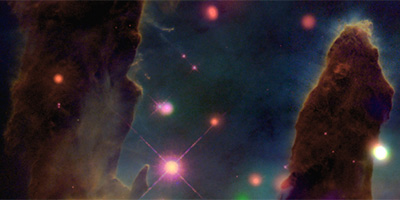Life Reaches for the Stars

There is a saying popularized by Carl Sagan that “we are stardust”. Sagan was referring to the fact that during the Big Bang, the only matter probably created was overwhelming hydrogen, significantly less helium and, relatively speaking, trace amounts of lithium and beryllium. The rest of matter would have to be forged in the heart of huge stars during their lives and deaths as super novae. Potentially, multiple generations of different stars could have seeded and shaped our corner of space before there was enough quantity and density to form dust clouds, a modest proto-star, planets and eventually life.
Even though we share this primordial kinship with our luminous progenitors, it can be daunting sense of scale to a single frail human.
But we have a magnificent scale of our own. While watching a documentary about the mechanisms of living cells, called Secret Universe, The Hidden Life of the Cell, the narrator mentioned in passing that each human cell contains about six feet of DNA if it were unwound into a straight strand. That alone is pretty impressive for an object we cannot even perceive with the naked eye, but taken collectively it is staggering.
The estimated number of cells in a healthy adult human body seems to vary greatly, but somewhere around 50 trillion seems to be the a reasonable consensus. That’s still a ridiculously large number unless you’re talking about the national debt. Instead, I’ll choose a clock.
This clock I am imaging counts backward, one single second for every cell in just your own body. It runs out around 1.6 million years ago. That’s a period in the past that paleontologists refer to as the “Hey I Just Figured Out This Rock is Sharper and Stronger Than My Teeth” era.
What about distance? At 6 feet for each cell and 50 trillion cells, that’s almost 57 billion miles. That’s over 11 trips around the sun for the ex-planet Pluto (which would take over 2700 years for what it is worth).
But Humans Are a Social Animal…
Plugging more people into the cellular clock I described above, it only takes the population of a small US town (about 8600 people) to run down to the beginning of the universe, 13.75 billion years ago.
As for distance, at the time of this article, the world’s population probably topped 7 billion this year. That’s a lot of people and a lot of cells. Using the previous figures we arrive at a collective strand almost 68 light years long. So what does 68 light years buy us in the astronomical candy store? It’s not a Black Titanium credit card, but it is still pretty impressive to me. That’s a chunk o’ space roughly 20 parsecs.
According the the Gliese star catalog that space contains about 2,127 stars. Sadly, those are only observed and cataloged stars, so the actual number may run much higher. And of the similarly modest number of exoplanets discovered so far, several lay within that range.
So that’s the unrelated train of thought I take after a good documentary. Maybe next time I’ll share some of the dreams and story ideas they often inspire.




















